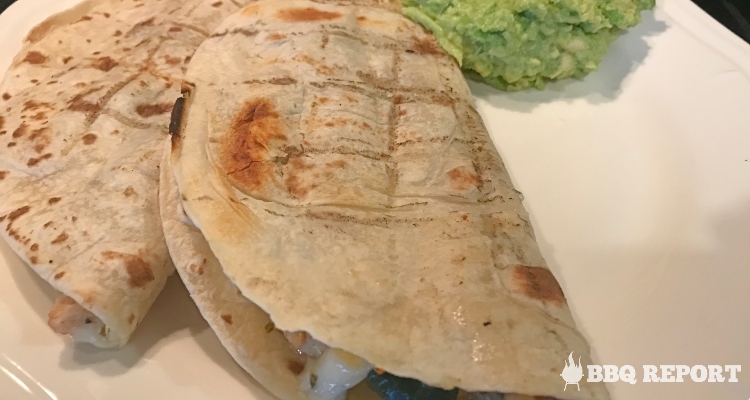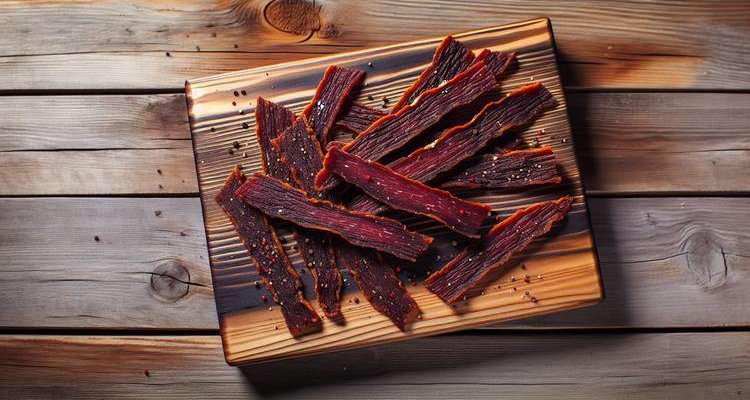
Nothing beats the satisfaction of making your own smoked beef jerky. Whether you’re looking to save money on expensive store-bought jerky or create custom flavors that match your taste perfectly, this smoked beef jerky recipe delivers tender, flavorful results every time. With just a few hours of smoking time and simple ingredients, you’ll have a batch of protein-packed snacks that rivals anything you can buy.
Why Make Homemade Smoked Beef Jerky?
Making beef jerky at home offers incredible advantages over store-bought options. First, you control exactly what goes into your jerky—no artificial preservatives, excessive sodium, or mystery ingredients. Second, you’ll save significant money, as homemade jerky costs roughly 40-50% less than premium commercial brands. Third, you can customize flavors endlessly, from classic teriyaki to spicy peppered varieties. Finally, smoking jerky is surprisingly forgiving, making it an excellent project for BBQ beginners who want to build confidence with low-temperature smoking techniques.
Choosing the Best Beef for Jerky
The foundation of great beef jerky starts with selecting the right cut of meat. You need lean cuts with minimal fat, as fat doesn’t dehydrate properly and can lead to rancidity during storage. Eye of round is the gold standard for beef jerky—it’s extremely lean, economical, and produces consistently excellent results. Top round and flank steak also work beautifully, though flank steak can be pricier. When choosing the right beef cuts, look for meat with a deep red color and trim away any visible fat or silver skin before marinating.
Understanding USDA beef grades can help you make informed decisions at the butcher counter. While Choice and Prime grades offer excellent marbling for steaks, Select grade actually works better for jerky since you want minimal fat content.
Essential Slicing Techniques
Proper slicing is critical for achieving the perfect jerky texture. Place your beef in the freezer for 1-2 hours before slicing—this firms up the meat and makes it much easier to cut uniform strips. Aim for 1/4-inch thickness for traditional chewy jerky, or slice thinner (1/8-inch) for crispier, brittle-style jerky.
The grain direction matters significantly. Cutting with the grain produces chewier jerky that requires more work to bite through, while cutting against the grain creates more tender, easy-to-eat pieces. For most people, cutting against the grain offers the best eating experience.
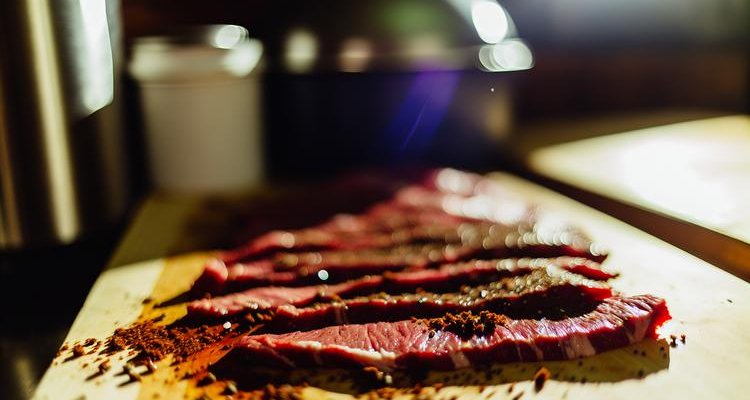
The Perfect Beef Jerky Marinade
A well-balanced marinade is what transforms plain beef into crave-worthy jerky. This recipe uses a classic combination that hits all the right flavor notes: soy sauce provides umami and saltiness, Worcestershire sauce adds tanginess and depth, brown sugar balances with sweetness, and a blend of garlic powder, onion powder, and black pepper rounds out the flavor profile. For additional depth, you can explore more marinade recipes to find your signature flavor combination.
Marinate the beef for at least 6 hours, though 12-24 hours delivers more intense flavor penetration. Place the sliced beef and marinade in a large zip-top bag, remove as much air as possible, and refrigerate. Flip the bag every few hours to ensure even coverage.
Smoking Temperature and Wood Selection
Temperature control is crucial for food-safe, delicious jerky. Smoke your beef jerky at 160-180°F, with 165°F being the sweet spot. This temperature range ensures you reach the USDA-recommended 160°F internal temperature for food safety while gently dehydrating the meat. Lower temperatures take longer and risk bacterial growth, while higher temperatures can cause “case hardening”—where the exterior dries too quickly and traps moisture inside.
For wood selection, hickory and mesquite provide bold, traditional smoke flavors that stand up well to the strong marinade. Apple and cherry offer milder, slightly sweet smoke profiles if you prefer subtler flavor. Many pitmasters recommend the best smoking woods for jerky include hickory for its robust character.
Step-by-Step Smoking Instructions
Remove the marinated beef from the refrigerator and pat each strip dry with paper towels—this helps smoke adhere better and promotes even drying. Arrange the strips directly on smoker racks in a single layer without overlapping. Make sure air can circulate around each piece.
Preheat your smoker to 165°F. Once at temperature, add your wood chips or chunks and place the racks of beef in the smoker. Smoke for 4-6 hours, checking for doneness starting at the 4-hour mark. Rotate the racks halfway through if your smoker has hot spots.
Jerky is done when it bends and cracks slightly but doesn’t break completely. It should have a leathery texture with no moisture pockets. The internal temperature should reach at least 160°F for food safety.
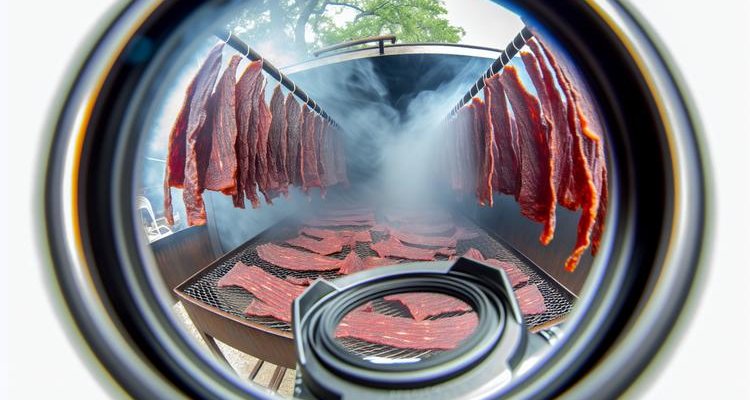
How to Tell When Jerky is Done
The bend test is your best indicator of doneness. Take a piece of jerky and bend it—properly smoked jerky should bend and crack slightly but not snap in half like a cracker. If it’s still very pliable and doesn’t crack, continue smoking. If it snaps cleanly, you’ve slightly over-dried it (still safe to eat, just more brittle).
Color is another indicator: finished jerky should be dark mahogany to nearly black, depending on your marinade ingredients. White spots or streaks indicate fat that wasn’t fully trimmed—these pieces won’t store as long but are still safe to eat immediately.
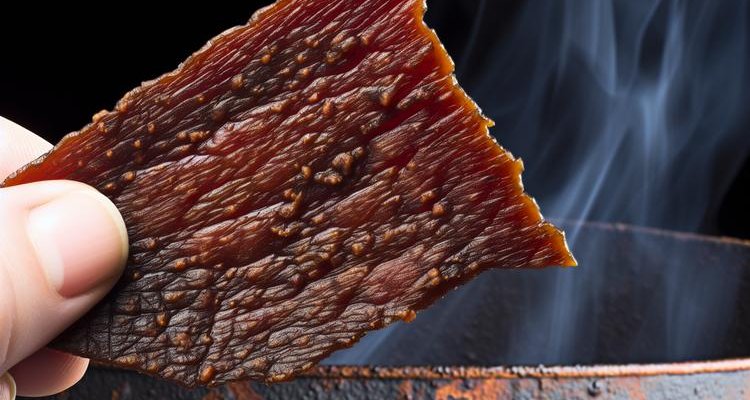
Storage and Shelf Life
Proper storage ensures your homemade jerky stays fresh and safe to eat. Allow the jerky to cool completely to room temperature before storing. Place in an airtight container or vacuum-sealed bags. Stored at room temperature in a cool, dark place, properly dried jerky lasts 1-2 weeks. Refrigerated, it extends to 1-2 months. For maximum shelf life of 6+ months, freeze your jerky in vacuum-sealed bags.
If you notice any mold, off smells, or sliminess, discard the jerky immediately. Properly dried jerky should feel dry to the touch and have no visible moisture.
Frequently Asked Questions
How long does smoked beef jerky last?
When stored properly in an airtight container at room temperature, smoked beef jerky lasts 1-2 weeks. Refrigeration extends shelf life to 1-2 months, while freezing in vacuum-sealed bags preserves jerky for 6+ months. The key is ensuring jerky is thoroughly dried with no moisture pockets and stored away from humidity.
What’s the best cut of beef for making jerky?
Eye of round is the best cut for beef jerky due to its lean composition, uniform shape, and economical price point. Top round and flank steak are excellent alternatives. Always choose cuts with minimal fat marbling, as fat doesn’t dehydrate properly and can cause jerky to spoil faster.
Can I make beef jerky in an electric smoker?
Absolutely! Electric smokers work exceptionally well for beef jerky because they maintain steady low temperatures (160-180°F) without constant monitoring. Just ensure your electric smoker can reach and hold 165°F, and use wood chips or pellets to generate smoke flavor.
Why is my jerky too tough or too dry?
Overly tough jerky typically results from slicing with the grain or over-smoking. For more tender jerky, slice against the grain and check for doneness starting at 4 hours. Jerky that’s too dry and brittle was either smoked too long, sliced too thin, or smoked at too high a temperature. The ideal texture bends and cracks slightly without breaking completely.
Can I adjust the marinade for different flavors?
Yes! This base recipe is highly customizable. For spicy jerky, add cayenne pepper, red pepper flakes, or hot sauce to the marinade. For teriyaki-style jerky, increase brown sugar and add ginger and sesame oil. For peppered jerky, coat strips heavily with cracked black pepper after marinating. Experiment with different marinades while maintaining the salt and acid components for food safety.
Smoked Beef Jerky Recipe: Easy Homemade Jerky in Your Smoker
Equipment
- Smoker or pellet grill Must maintain 160-180°F temperature range
- Sharp slicing knife For uniform beef strips
- Large zip-top bags or non-reactive container For marinating
- Paper towels For drying beef before smoking
- Smoker racks For arranging jerky
- Instant-read thermometer To verify 160°F internal temperature
- Wood chips or chunks Hickory, mesquite, apple, or cherry
Ingredients
Main Ingredients
- 2 pounds eye of round beef Top round or flank steak also work well; trim all visible fat
Marinade
- 1/2 cup soy sauce Low-sodium works well
- 3 tablespoons Worcestershire sauce
- 3 tablespoons brown sugar packed
- 1 teaspoon garlic powder
- 1 teaspoon onion powder
- 2 teaspoons black pepper freshly ground preferred
- 1/2 teaspoon liquid smoke optional, for enhanced smoke flavor
Instructions
- Place the trimmed beef in the freezer for 1-2 hours until partially frozen but not solid. This makes slicing much easier. Using a sharp knife, slice the beef against the grain into 1/4-inch thick strips for chewy jerky, or 1/8-inch for crispier texture. Trim any remaining fat or silver skin from each strip.
- In a large bowl or measuring cup, whisk together soy sauce, Worcestershire sauce, brown sugar, garlic powder, onion powder, black pepper, and liquid smoke (if using) until the sugar is fully dissolved.
- Place the beef strips in a large zip-top bag or non-reactive container. Pour the marinade over the beef, ensuring all pieces are coated. Remove as much air as possible from the bag and seal. Refrigerate for 12-24 hours, flipping the bag every few hours for even coverage. Minimum marination time is 6 hours.
- Remove the beef from the marinade and pat each strip dry with paper towels. This helps the smoke adhere better and promotes even drying. Discard the used marinade.
- Preheat your smoker to 165°F. Add your choice of smoking wood—hickory or mesquite for bold flavor, or apple and cherry for milder smoke. Ensure the smoker maintains steady temperature between 160-180°F throughout the smoking process.
- Arrange the dried beef strips directly on smoker racks in a single layer without overlapping. Leave space between strips to allow air circulation. If using multiple racks, note that you may need to rotate them halfway through smoking for even drying.
- Place the racks in the preheated smoker. Smoke for 4-6 hours, checking for doneness starting at the 4-hour mark. Rotate racks halfway through if your smoker has hot spots. The jerky is done when it bends and cracks slightly but doesn't break completely, with an internal temperature of at least 160°F.
- Remove the finished jerky from the smoker and allow it to cool completely to room temperature on wire racks. Once cool, store in an airtight container or vacuum-sealed bags. Room temperature storage: 1-2 weeks; refrigerated: 1-2 months; frozen: 6+ months.
Notes
Contents
- Why Make Homemade Smoked Beef Jerky?
- Choosing the Best Beef for Jerky
- Essential Slicing Techniques
- The Perfect Beef Jerky Marinade
- Smoking Temperature and Wood Selection
- Step-by-Step Smoking Instructions
- How to Tell When Jerky is Done
- Storage and Shelf Life
- Frequently Asked Questions
- Smoked Beef Jerky Recipe: Easy Homemade Jerky in Your Smoker

